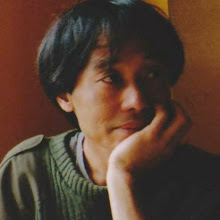As I mentioned in my previous post, San Francisco-based Mexican performer Violeta Luna’s workshop took place from March 26 to 28, 2016 at the Sofia University in Tokyo. She was invited by Professor Emiko Yoshikawa specializing in Latino-American culture. The professor believes that culture and society should be understood not only by reading texts but also by physical experience. As one of the participants, I am grateful for her enthusiasm because few workshops that consider making performance art as political actions are held in Japan, though many ones that teach skills are. The majority of participants were artists struggling to create something that has to do with social and political issues. A few of them were relatively well-known among the art circle in Tokyo.
So, contrary to general perception, it is not that few Japanese artists make political statements by their pieces. On the other hand, I sometimes see that some Japanese artists' strange behavior that they claim their pieces “not political’’ when asked, even though their pieces involve some kind of political statement. I remember, for example, documentary filmmaker Linda Hoaglund at the talk show after the screening of her ANPO: Art X War (2010)--which studied how Japanese artists had been responding to the US military presence in Japan--reported that Japanese artist Makoto Aida said his painting in which Japanese fighter aircraft attacking New York was not political. Why did he say so?—I guessed that he had to be protective because his piece drew criticisms in New York. I am not criticizing him, but, did he know that his remark would not change the nature of his work?
It can be said that many Japanese artists think that making political statements can risk their careers. There is social--or, market, if you like--pressure that conforms them to the idea that art should have nothing to do with politics. There is also direct involvement of the authority that suppresses them, such as arresting an artist whose pieces are created from 3D printings of her vagina. Moreover, the pieces that criticize the Abe administration are often (self) censored by art museums and public facilities at which the directors cowardly avoid controversy. Therefore the artists can strategically choose to claim their pieces "not political."
On the other hand, from the artists' practical point of view, the ambiguity of their pieces remain important. Many may think their pieces should be open to interpretation, or they simply take the issues to the street.
Violeta Luna's pieces seem to retain such ambiguity, although her pieces make her anti-global capitalism, anti-violence, anti-racism, and anti-sexism position obvious (and she sometimes takes her pieces to the street). Marina Abramović maybe her inspiration, but her ritualistic gestures and colorful installations are unique to her.
At the workshop, we learned her rather an intuitive approach to "installation"--placing the props and bodies. Every participant was asked to bring objects and costumes that have something to do with their identity. We put them together in a corner of the room and share them when making installations. We were not asked to explain how the objects and costumes we brought relate to identity--and that was good, I think. We can share ideas not only verbally, but also visually, or physically. When you talk too much, the creative process often halts. We are divided into smaller groups, given themes such as "globalization," "Japan 2016," "yourself you do not want to show," etc., and improvised. The schedule was tight, so we did not have much time to talk, and that was good, too.
At the end of the workshop, each participant made their solo pieces. They were from various backgrounds, so were the pieces--some were dance, some were music, some were a theatrical play, and some were installations. They were honest pieces.
My piece is related to my past. In 2004, I was among the struggling artists who were invited to an artist in residence program in Kortrijk, Belgium. We were allowed to have a 3 month-working period and presentations at a festival. I brought my materials which are slide photos of street name signs of a newly built residential area in a suburb of Brussels. Strangely, the streets were named after Hollywood celebrities, such as “Chemin Alfred Hitchcock,” “Rue James Dean,” “Rue Audrey Hepburn,” “Rue Marilyn Monroe,” etc. The idea that doing iconic moments of these film stars easily came to me, but I was reluctant to do so because it was what Jérôme Bel, whose pieces often play with cultural icons, could have done. I liked artists such as Bel, Xavier Le Roy, and Mette Edvardsen, those who created brilliant pieces with simple ideas and clarity. But, I could not find a way of making something as good as theirs without aping them. So, I dropped the initial idea and made an installation. At the workshop, I came back to this initial idea.




No comments:
Post a Comment